
Back pain pillows are part of the ever-widening line of products designed to minimize the symptoms of common dorsopathy conditions. Special pillows for back and neck pain come in many styles and applications. Most are available at orthotic supply stores, doctors, bedding retailers or online. Purchasing back pain relief products over the internet is a great convenience for patients who have been restricted in their physical activities due to their chronic pain. Always remember that although pillows are nice creature comforts, they are unlikely to solve your back or neck pain problems completely. Pillows may help to minimize symptoms when sleeping or sitting, but will not typically address the underlying cause of pain.
Let’s take a close look at some of the most popular types of pillows marketed to back and neck pain sufferers.
Back Pain Pillow Selection
Many styles of special back pain pillows are made from memory foam, which maximizes comfort and support. Others may be polyester or down-filled. The cheapest pillows may simply consist of a piece of inexpensive closed cell foam covered in fabric. Be sure to compare quality and materials when purchasing any pillow and do not just consider the price. Here are some of the many types of back and neck pain pillows on the market today:
Curved ergonomic cervical pillows replace old flat -style sleeping pillows. The shape of these pillows cradles the head and allows for a natural sleeping posture for the neck. These pillows claim to decrease the overall stress on the spine, especially in the upper back and neck.
Small wedge-shaped lumbar pillows can be used under the lower back to provide support for painful lower back injuries. These pillows can be used effectively when the patient is lying on their back (supine) or seated.
Large wedge designs are also popular to provide an incline for the upper back. These pillows make it possible to maintain an almost seated position in bed. They are similar to adjustable beds, in that they make rising from a reclined position much easier.
Large flat cushions can be used to elevate ankles and feet. Some back pain patients get relief from sciatica through the use of these leg pillows.
Knee pillows are often used when a patient is lying on their side. These shaped cushions maintain the space between the knees, decreasing lower back pain and pressure. They are also commonly called knee or leg spacers.
Facedown pillows are cut out to provide a comfortable prone position for the head and face. These pillows resemble the upper portion of a chiropractor’s bench or massage table.
Roll pillows are favorites to hold for many upper back and shoulder pain patients. In this application, they can support the shoulder and take the weight off the arm, reducing pain. These can also be used to elevate the knees, be placed between the knees or be wedged behind the patient when seated.
Full body pillows can replace knee pillows and roll pillows, by doing 2 jobs at once. A full body pillow can also prevent unwanted turning in one’s sleep.
Travel pillows are used for napping during plane or train trips. These horseshoe-shaped pillows provide support for the head and neck when one must sleep sitting up.
Many varieties of specialty pillows listed above can also be purchased in inflatable models, which are ideal for traveling.
Experiences with Back Pain Pillows
I have tried many of these devices during my decades of suffering with agonizing back ache. I tried so many styles and brands that I really do consider myself a bit of an expert on back pain pillows. (What a useless and unmarketable base of knowledge.)
I got rid of my ergonomic curved pillows and now use a conventional poly-filled pillow. I need my pillow to be overfilled, since I have wide shoulders, sleep on my side and have a tricky neck at this stage of life. Pillows that are too flat seem to aggravate my cervical spinal issues. I also sleep with a pillow between my knees, but only for comfort.
Finding the best pillow for your anatomical and pain-specific requirements is often a process of trial and error. It might be best to purchase several pillows from a retailer with an easy exchange policy and simply try each over consecutive nights in order to ascertain which suits your preferences best. Luckily, most pillows are affordable, although some can be rather pricey. However, compared to other back pain relief products, finding a quality pillow, that can minimize pain, should not be a budget-breaker.




